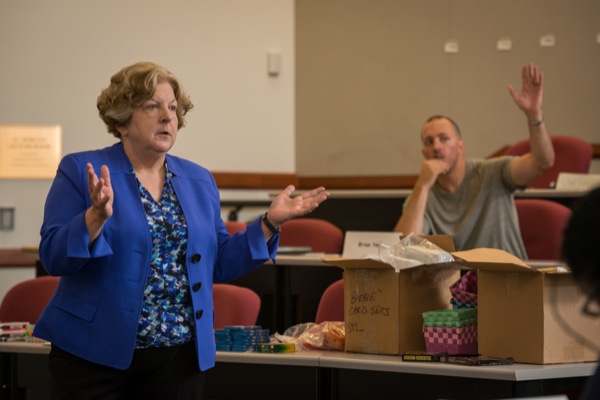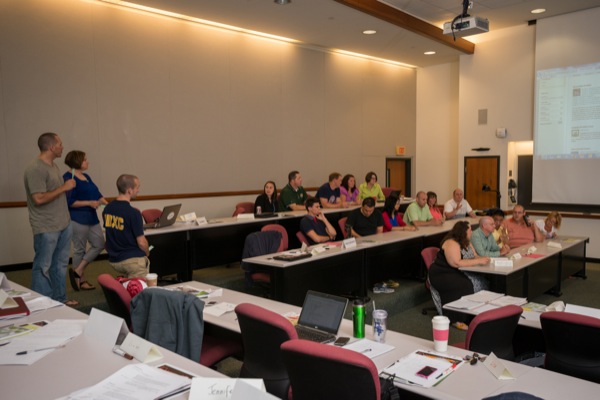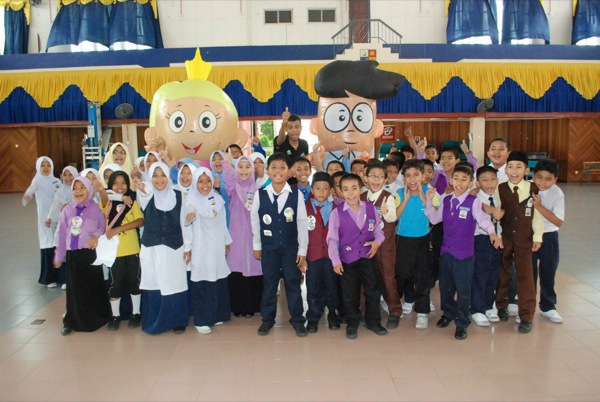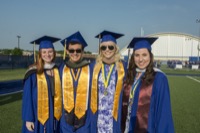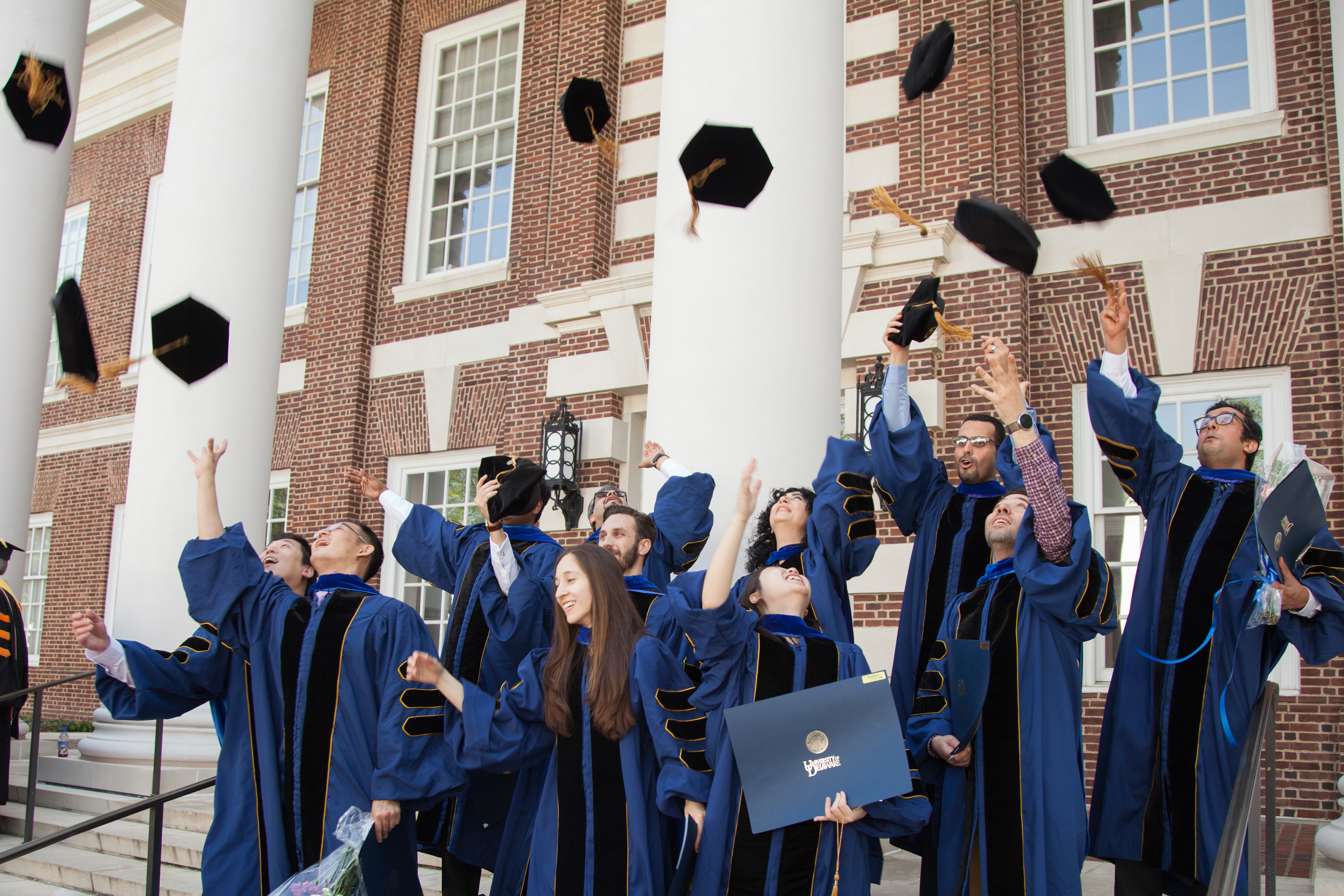

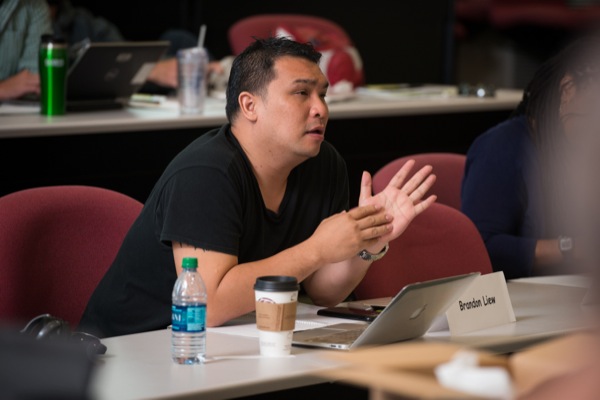
Spreading financial literacy
MAEEE students present recent accomplishments, work with UD alumna
1:52 p.m., July 23, 2014--“It’s one thing to know economics, but another to teach it well,” said Mary Suiter, a 1989 University of Delaware graduate and recent Alfred Lerner College of Business and Economics Alumni Award of Excellence recipient, who led students in a day-long workshop on economic education earlier this month.
The workshop was held as a part of the master of arts in economics and entrepreneurship for educators (MAEEE) program in UD’s Lerner College, which is designed to equip students with strategies for teaching economics, entrepreneurship and financial education.
Campus Stories
From graduates, faculty
Doctoral hooding
The current MAEEE cohort included educators from three countries and 14 states, including six teachers in the state of Delaware.
“I’m very grateful to have my degree from UD,” said Suiter, who herself is an MAEEE graduate and currently works as the manager of economic education for the Federal Reserve Bank of St. Louis. Within the Fed, Suiter has created a five-member education team, three of whom are MAEEE graduates and a fourth who is a graduate of UD’s doctoral program in economic education.
Suiter credits the MAEEE program with helping her to hone skills like presenting a workshop and developing a curriculum.
“Those lessons were really useful in my career,” said Suiter, who has put them to good use in developing a wide range of educational resources for both students and teachers through the St. Louis Fed.
During the workshop, Suiter demonstrated and explained such resources, like print lessons, podcasts, video series and games. Her hope is that MAEEE students take from her workshop a sense of what can be achieved with their UD education.
“Students can take this degree and make it something invaluable for them, whether they stay in the classroom or they move on to other opportunities,” said Suiter.
Current MAEEE students are already proving what they can accomplish with their newly honed skills. On July 7 they gathered for round-table discussions to present the results of projects they developed over the course of the last year.
Each student’s project furthered economic, entrepreneurship and personal finance education and policy in their home communities. The positive effects of their projects will continue to be felt throughout these schools, districts, states and countries for years to come.
‘CashVille Kidz’
MAEEE student Brandon Liew sought to establish the first financial education program in schools in his home country of Malaysia. The result was CashVille Kidz, an educational animated series that has become a favorite of children across Malaysia.
Broadcast on national television in Malaysia with a viewership of more than 1.5 million, each episode of CashVille Kidz teaches a specific lesson about positive financial habits.
“One of the most effective ways of getting students to learn is really to entertain them,” said Liew, who called the approach “edutainment.” Working with Malaysia’s Ministry of Education as well as MayBank, Malaysia’s largest bank, Liew also developed CashVille Kidz classroom materials and an online portal.
The CashVille Kidz program, targeted at ages nine through 12, was implemented at 180 schools and reached over 50,000 students. In addition to television episodes and workbooks for students and teachers, the program also includes activities that allow students to mimic a real economy in the classroom.
“The activities are designed to allow students to learn from experience,” said Liew. “When a student comes to class, we give them play money. Each of them are given a job card that tells them what their job is, how much the pay is and how to get promoted.”
Each classroom also has its own “bank” in which students can use credit cards, make purchases and even take out loans.
Within Malaysia, the program has received very positive reviews from teachers and students alike. Some children have even thrown birthday parties featuring the characters of Liew’s cartoon. Liew hopes to expand CashVille Kidz to other countries like Singapore, Indonesia and Thailand.
“The whole idea is to really allow the child to experience the lesson,” said Liew. “We created an entire economy inside the class so that the students live it.”
‘Improving Global Citizenship Education’
“Financial and economic literacy is not a subject that seems to be accessible for marginalized populations,” said MAEEE student Romina Kasman, whose project seeks to “strengthen the capacities of educators in informal education environments to teach economic and financial literacy in a way that empowers marginalized youth and adults.”
Working as an intern for the Peruvian Superintendence of Banks and Insurance, Kasman created and reviewed financial literacy resources for children and adults throughout Peru.
Kasman also worked with POETA, a program aimed at providing youth and adults with skills to improve opportunities for labor and social inclusion. During her work with POETA, Kasman developed a 250-page guide for informal educators.
“I designed five models, three in economic education and two on financial literacy,” said Kasman of the guide, which provides educators with step-by-step instructions and materials.
Kasman is in the process of expanding these materials to be accessed by educators throughout Latin America.
As a result of her work, Kasman has been invited to meet with experts at the Organization of American States, the United Nations and UNESCO. She also delivered a three-day workshop to educational authorities at Peru’s Ministry of Education on how to design Peru’s standards of economic and financial literacy.
“Most excitingly, now global citizenship education, unlike in the past, includes a dimension on personal finance,” said Kasman. “So personal finance is becoming more and more important in citizenship education.”
‘Economics of War in the 21st Century’
Jeremy Miller, MAEEE student and teacher at Hinckley-Finlayson High School in Hinkley, Minnesota, was in the Marine Corps and also served overseas as a security contractor for over three years. The experience he acquired there has proven to be helpful in teaching economics from an interesting new perspective.
“I have found that students generally get very engaged when I apply my overseas experiences to a lesson,” said Miller. “My hope is for other teachers to use my experiences and others related to international conflict to make economics more engaging.”
Miller worked with Cindy Fitzhum, a 2011 MAEEE graduate and director of the Center for Economic Education at St. Cloud University, to develop a series of lesson plans called “Economics of War in the 21st Century.” They presented the lessons at conferences in New York and Minnesota and distributed the lessons to teachers for use in their own classrooms.
“I’ve been able to put lessons in the hands of teachers that will hopefully make economics more relevant and enjoyable,” said Miller. He hopes to distribute these lessons to more educators and eventually publish them.
Miller’s curriculum touches on subjects like pay rates for members of the military, supply and demand in a combat zone and a classroom debate about the size of the military. Students also discuss international economic situations in Syria, Iraq and Afghanistan.
“We talked about the supply and demand for copper, which was used in a weapon that can penetrate armor,” said Miller. “But they couldn’t use it because the copper was so expensive. So I tell my kids that economics can save your life.”
Article by Sunny Rosen
Photos by Kathy F. Atkinson and courtesy of Brandon Liew




